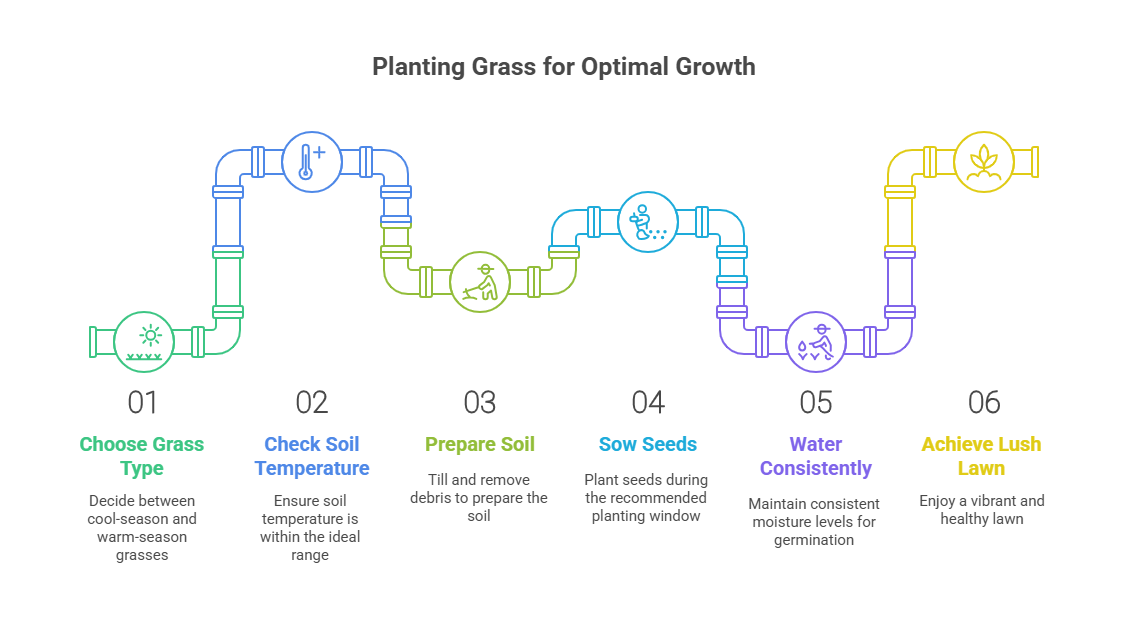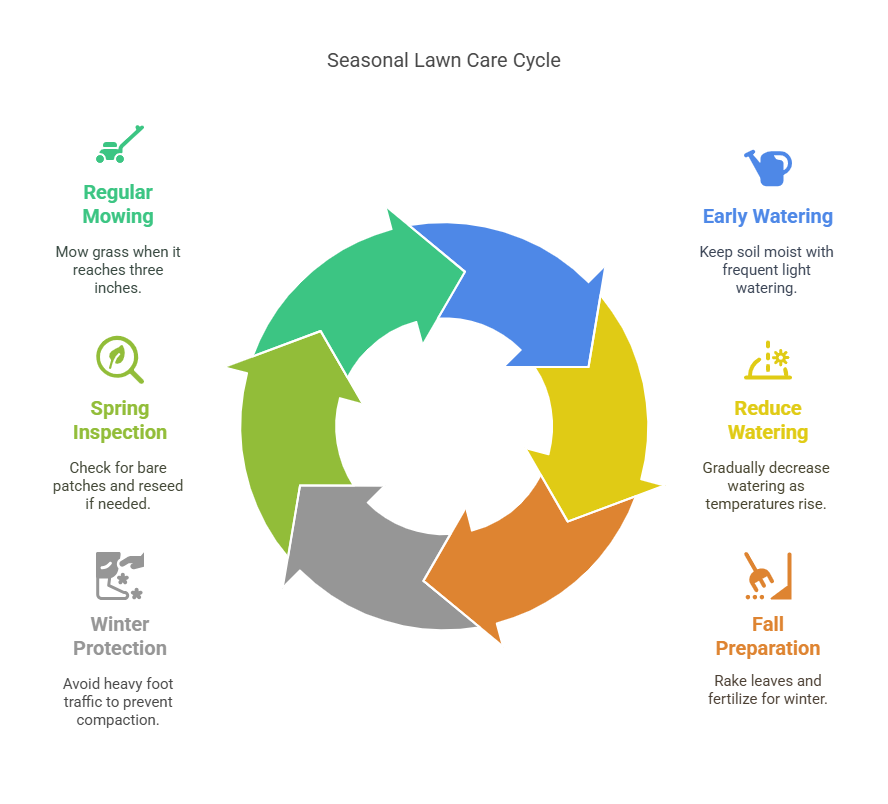When Should You Plant Grass Seed? Best Timing for a Lush Lawn

The best time to plant grass seed depends on the type of grass and your local climate. If you're going with cool-season grasses, aim for early spring or early fall when soil temperatures are between 50°F and 65°F. For warm-season grasses, wait until late April to early June, when soil hits 65°F to 70°F. Proper soil preparation and attention to moisture can enhance germination. Explore more tips and insights to guarantee you achieve that lush lawn you desire.
- Cool-season grasses should be planted in early spring or early fall, ideally when soil temperatures are 50°F to 65°F.
- Warm-season grasses thrive when planted from late April to early June, with soil temperatures between 65°F and 70°F.
- Regional climate and weather patterns play a crucial role in determining the best planting times for grass seeds.
- Proper soil preparation, including clearing debris and testing pH, is essential for successful seed germination.
- Consistent moisture levels during germination significantly contribute to establishing a lush and healthy lawn.
Understanding Grass Types
When you’re ready to plant grass seed, understanding the different grass types is essential for your success. Each type has unique characteristics and thrives in specific conditions, so knowing your options can help you make the best choice. For instance, warm-season grasses like Bermuda and Zoysia flourish in sunny, hot climates, while cool-season grasses, such as Kentucky bluegrass and fescue, prefer cooler temperatures. Consider your local climate, sun exposure, and soil type when selecting grass seeds. Also, think about how you’ll use your lawn—whether for play, aesthetics, or low maintenance. By choosing the right grass type for your environment and needs, you’ll set the foundation for a lush, healthy lawn that you can enjoy for years to come.
Cool-Season Grasses: Ideal Planting Times
If you've chosen a cool-season grass type for your lawn, knowing the best times to plant is key to achieving vibrant growth. The ideal time to sow your seeds is in early spring or early fall. In spring, aim for soil temperatures between 50°F and 65°F, allowing your grass to establish before the heat of summer. Conversely, in early fall, plant when temperatures cool down, ideally between mid-August and mid-September. This timing gives your grass the chance to take root before winter arrives. Make sure to prepare your soil properly and water consistently to encourage healthy germination. With the right timing and care, your cool-season grass will flourish, giving you a lush and beautiful lawn.
Warm-Season Grasses: Optimal Timing
For those opting for warm-season grasses, timing your planting can greatly impact your lawn's health and appearance. Ideally, you should plant your seeds when soil temperatures consistently reach 65°F to 70°F, typically in late spring to early summer. This warm environment encourages quick germination and establishes strong roots. Aim for a window between late April and early June for the best results.
Before planting, make sure to prepare the soil by tilling and removing any debris. Water the area thoroughly after sowing, and maintain consistent moisture levels during the germination phase. By choosing the right time and conditions, you’ll set your warm-season grasses up for a lush, vibrant lawn that thrives throughout the warmer months.

Regional Considerations for Planting
Understanding your region's climate and growing conditions is vital for successful grass seed planting. Different areas experience varying temperatures, rainfall, and soil types, all of which impact the best time to sow seeds. For instance, in the northern regions, early spring or early fall is ideal for cool-season grasses, while southern areas thrive with warm-season varieties planted in late spring. It’s essential to pay attention to local weather patterns—like frost dates and average rainfall—to guarantee peak growth. Additionally, consider your lawn's sun exposure and drainage, as these factors can influence seed selection and timing. By aligning your planting schedule with your region’s specific conditions, you’ll set yourself up for a lush, healthy lawn.
Preparing Your Soil for Seeding
Before you sow your grass seeds, preparing the soil is essential for ensuring ideal growth and health. Start by clearing the area of debris, rocks, and weeds. Next, test your soil’s pH level; a range of 6.0 to 7.0 is best for most grasses. If needed, amend your soil with lime or sulfur to adjust the pH. Loosen the top 2 to 4 inches of soil using a rake or tiller, allowing for better seed-to-soil contact. Incorporate organic matter, like compost, to improve drainage and nutrients. Finally, level the surface to prevent pooling water. With well-prepared soil, you’re setting the stage for a lush, healthy lawn that thrives once you plant those seeds.
.jpg)
Factors Influencing Grass Seed Germination
While planting grass seed may seem straightforward, several factors can greatly influence germination and establishment. First, temperature plays an essential role; most grass seeds thrive in soil temperatures between 50°F and 65°F. Next, moisture is vital; seeds need consistent watering to sprout, but too much can lead to rot. Additionally, light exposure matters—some seeds require sunlight for germination, while others prefer shade. Soil quality also impacts success; well-aerated, nutrient-rich soil promotes better growth. Finally, the type of grass seed you choose should match your climate and intended lawn use. By paying attention to these factors, you can set the stage for a lush, healthy lawn that thrives all season long.
Tips for Overseeding an Existing Lawn
Overseeding an existing lawn can rejuvenate tired grass and fill in bare patches, enhancing its overall appearance and health. To get started, mow your lawn short to expose the soil, and rake away any debris. This helps the new seeds make good contact with the soil. Choose a high-quality grass seed that matches your existing lawn type for seamless growth. Spread the seed evenly, either by hand or with a spreader, ensuring adequate coverage. After seeding, lightly water the area to keep the soil moist but not soggy. Finally, consider applying a thin layer of mulch or topsoil to protect the seeds from birds and promote germination. With proper care, you’ll enjoy a thicker, healthier lawn in no time!
Seasonal Lawn Care After Planting

Once you've planted your grass seed, maintaining proper care throughout the seasons is essential for establishing a healthy lawn. In the early weeks, keep the soil consistently moist but not soggy; frequent light watering works best. As temperatures warm, gradually reduce watering frequency while ensuring deep roots develop.
In the fall, focus on raking leaves and applying a suitable fertilizer to prepare your lawn for winter. During winter, avoid heavy foot traffic to prevent soil compaction.
Come spring, inspect your lawn for bare patches that may need reseeding, and keep up with regular mowing once the grass reaches about three inches. By following these seasonal care tips, you’ll enjoy a lush, vibrant lawn all year round.
Conclusion
Timing is everything when it comes to planting grass seed for a lush lawn. By understanding the differences between cool-season and warm-season grasses, you can choose the best time for your region. Don’t forget to prepare your soil and consider factors that influence germination. Whether you’re starting fresh or overseeding, following these tips will set you up for success. With the right care, you’ll soon enjoy a vibrant, healthy lawn that enhances your outdoor space.









